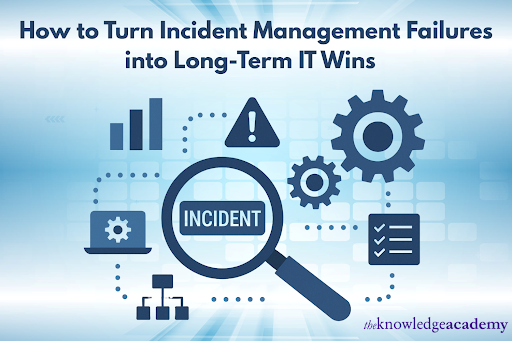How to Turn Incident Management Failures into Long-Term IT Wins
Is your incident management system meeting expectations, or is it like you’re constantly firefighting? What if your approach’s failures could set the stage for long-term success? That’s the power of a strong ITIL framework. By learning from an ITIL Course, your organisation can evolve its ITIL Incident Management practices, creating smoother processes and minimising disruptions.
Instead of seeing incidents as mere roadblocks, consider them valuable insights to drive improvement. So, how do you turn those painful failures into IT wins that last? Let’s explore how the right approach can turn your incident management setbacks into opportunities for growth, stability, and long-term success.
Table of Contents
Key Strategies for Turning Incident Management Failures into Wins
Dealing with incident management breakdowns calls for a thorough strategy. It is about enhancing the system overall, not only about resolving the current problem. These are the key strategies your team may use to make failures into long-term IT triumphs:
Identifying the Root Cause of Incidents
The first inclination during an incident is usually to remedy things quickly, which is very reasonable. Still, finding the underlying source of the problem is among the most crucial steps in turning failure into success. Many times, events are manifestations of more serious underlying issues. Ignoring these fundamental problems will probably cause similar events to recur, compromising your team’s capacity to create a strong system.
Knowing the root cause requires a methodical technique, including root cause analysis (RCA) or post-incident evaluations. Not only is the current problem fixed, but the underlying cause is also sought to understand how such problems might be avoided going forward. Techniques like Failure Mode and Effects Analysis (FMEA) or Five Whys will help you dissect the issue and identify solutions beyond temporary fixes.
Teams that learn to spot and fix the fundamental problems stop reoccurring events, enabling better, more effective operations. This strategy reduces disturbance over time and raises service standards.
Implementing a Learning Culture
Many companies view events as failures that should be covered up or dismissed. This is a crucial error. Establishing a learning culture inside your company can help you turn events into long-term gains.
This encourages your staff to see events as opportunities for development rather than causes of liability. Failures should be transparently examined, and lessons should be shared throughout the company. Organising frequent post-incident reviews or “blameless” retrospectives, where the emphasis is on learning from the event and avoiding similar problems in the future, helps one apply this.
A robust learning culture enhances one’s reaction to upcoming events and motivates team members to be more aggressive in spotting possible hazards before they become more serious. By developing this thinking, your team will be more ready to face upcoming difficulties and keep enhancing incident handling procedures.
Building a Proactive Incident Management System
Using a reactive approach to event management can lead to a never-ending loop of difficulties, with your staff left scurrying to fix problems as they develop. Developing a proactive incident management system that forecasts possible events before they start will help to break this loop.
Including monitoring solutions with a real-time view of your systems and networks can help you do this. Early identification of problems allows teams to act before a major incident starts. Moreover, a proactive incident management system entails routinely reviewing systems and procedures to find possible flaws and hazards. Predictive analytics and artificial intelligence tools can also help forecast and prevent incidents by spotting trends and patterns that might otherwise go undetectable.
Creating a proactive system requires a shift from responding to problems as they develop to first-hand prevention. This results in fewer accidents and more seamless operations, freeing your staff to concentrate on innovation and expansion rather than constantly juggling disturbances.
Leveraging Technology for Continuous Improvement
Digital times depend on technology to maximise incident management. Using the correct tools and technology can help you to constantly enhance your IT operations, lower reaction times, and simplify incident management procedures.
Many technologies abound that can help automate incident identification and resolution. For instance, automation technologies can reduce the requirement for human involvement by triggering alarms and reactions depending on predefined criteria. By studying past data and identifying trends, machine learning systems can also assist in forecasting and stopping possible events.
Another crucial technology to consider is a thorough IT service management (ITSM) platform, which centralises incident tracking, ticketing, and communication. This guarantees that no incident goes unsolved and lets your staff react to events more rapidly. Constant integration and improvement of these technologies will help you create an incident management system that solves problems and learns and advances with time.
Conclusion
Though it takes time, turning incident management mistakes into long-term benefits is achievable with the correct strategy. Identifying the causes of events, encouraging a learning culture, developing a proactive incident management system, and using technology will help you turn obstacles into stepping stones towards more success. Consider The Knowledge Academy courses to hone your incident management techniques and give your staff the tools to turn failures into long-term IT successes.
INTERESTING POSTS
About the Author:
Meet Angela Daniel, an esteemed cybersecurity expert and the Associate Editor at SecureBlitz. With a profound understanding of the digital security landscape, Angela is dedicated to sharing her wealth of knowledge with readers. Her insightful articles delve into the intricacies of cybersecurity, offering a beacon of understanding in the ever-evolving realm of online safety.
Angela's expertise is grounded in a passion for staying at the forefront of emerging threats and protective measures. Her commitment to empowering individuals and organizations with the tools and insights to safeguard their digital presence is unwavering.







